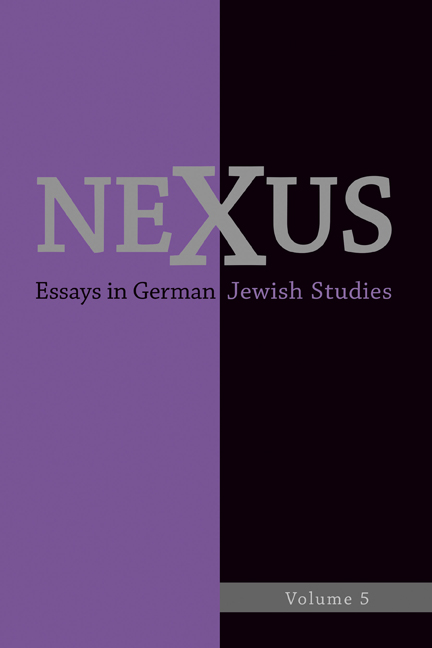 Nexus: Essays in German Jewish Studies, Volume 5
Nexus: Essays in German Jewish Studies, Volume 5 Book contents
- Frontmatter
- Dedication
- Contents
- Miscellaneous Frontmatter
- Introduction: Moments of Enlightenment for Jews and Other Germans
- Remembering Jonathan
- Jonathan M. Hess: Curriculum Vitae
- Maurice Sendak’s Dear Mili: A Contrapuntal Elegy
- Pluralism and the Modernized Jesus in Mendelssohn, Schiller, and Schleiermacher
- The Papal Game: Telling a Jewish Story from the Mayse bukh, Ayzik Meyer Dik and Marcus Lehmann
- The Fuzziness of Jewish and Non-Jewish Boundaries in Viennese Popular Culture around 1900: A Trend Toward “Similarity”?
- Freeing the Shtetl from the Ghetto Prism: Sholem Asch and Dovid Bergelson in German Translation
- A Poetics of Genocide: The Jewish Dead Confront the Germans in Katzenelson’s Warsaw Ghetto Poem “Vey dir”
- Appendix: “Vey dir”
- The New Ostjude and the Enlightened Ostdeutschen: Jewish Theater in the German Democratic Republic
- German Jewish lengevitch: A Plurilingual Poetics of Meddling
Maurice Sendak’s Dear Mili: A Contrapuntal Elegy
Published online by Cambridge University Press: 24 March 2021
- Frontmatter
- Dedication
- Contents
- Miscellaneous Frontmatter
- Introduction: Moments of Enlightenment for Jews and Other Germans
- Remembering Jonathan
- Jonathan M. Hess: Curriculum Vitae
- Maurice Sendak’s Dear Mili: A Contrapuntal Elegy
- Pluralism and the Modernized Jesus in Mendelssohn, Schiller, and Schleiermacher
- The Papal Game: Telling a Jewish Story from the Mayse bukh, Ayzik Meyer Dik and Marcus Lehmann
- The Fuzziness of Jewish and Non-Jewish Boundaries in Viennese Popular Culture around 1900: A Trend Toward “Similarity”?
- Freeing the Shtetl from the Ghetto Prism: Sholem Asch and Dovid Bergelson in German Translation
- A Poetics of Genocide: The Jewish Dead Confront the Germans in Katzenelson’s Warsaw Ghetto Poem “Vey dir”
- Appendix: “Vey dir”
- The New Ostjude and the Enlightened Ostdeutschen: Jewish Theater in the German Democratic Republic
- German Jewish lengevitch: A Plurilingual Poetics of Meddling
Summary
for Jonathan
The following essay was presented as the keynote lecture at the “Moments of Enlightenment” symposium. It was written as a conversation with the audience, and also as a conversation I would have liked to have had with Jonathan Hess. Jonathan and I shared common research interests in the Enlightenment and in German Jewish Studies. We also shared, I think, a deep appreciation for children's books, and certainly a deep appreciation for Harry Potter and its innovation. For these reasons I felt that these comments about Maurice Sendak's tremendously creative illustrations for Wilhelm Grimm's tale Dear Mili would be a fitting tribute to Jonathan. Sendak once wrote that “My best friends in the profession are people I rarely see but whose natures and work I love.” Jonathan was precisely this type of best friend in the profession to me.
Sendak's illustrations for Dear Mili are stunning in their complexity and their artistry. In the course of my research for this project, I have come to understand that Sendak drew heavily on multiple sources in his work. His illustrations are often profoundly personal, and resonate on many different levels. The images in one illustration come together and cohere; they do not necessarily resolve in a single meaning or a clear message. They are visual poems that work as multiplicity, and they are, very simply, beautiful. The German poet and philosopher Friedrich Schiller famously said of Beauty, “its whole magic resides in its mystery, and in dissolving the essential amalgam of its elements we find we have dissolved its very Being.” In what follows, I present an analysis of but one aspect of Sendak's beautiful illustrations, and in so doing I hope not to have dissolved their magic or their mystery.
MAURICE SENDAK once described his book illustrations as “visual poems,” suggesting their inherent lyrical resonance, and in a seminal essay from 1964, “The Shape of Music,” he identifies a “quickening,” an animating, rhythmic, impulsive musical principle as a key source that inspires his artwork. “For me,” Sendak writes, “to conceive musically means to quicken the life of the illustrated book”; “To quicken means, for the illustrator, the task of first comprehending the nature of his text and then giving life to that comprehension in his own medium, the picture.”
- Type
- Chapter
- Information
- Nexus: Essays in German Jewish Studies, Volume 5Moments of Enlightenment: In Memory of Jonathan M. Hess, pp. 21 - 40Publisher: Boydell & BrewerPrint publication year: 2021
